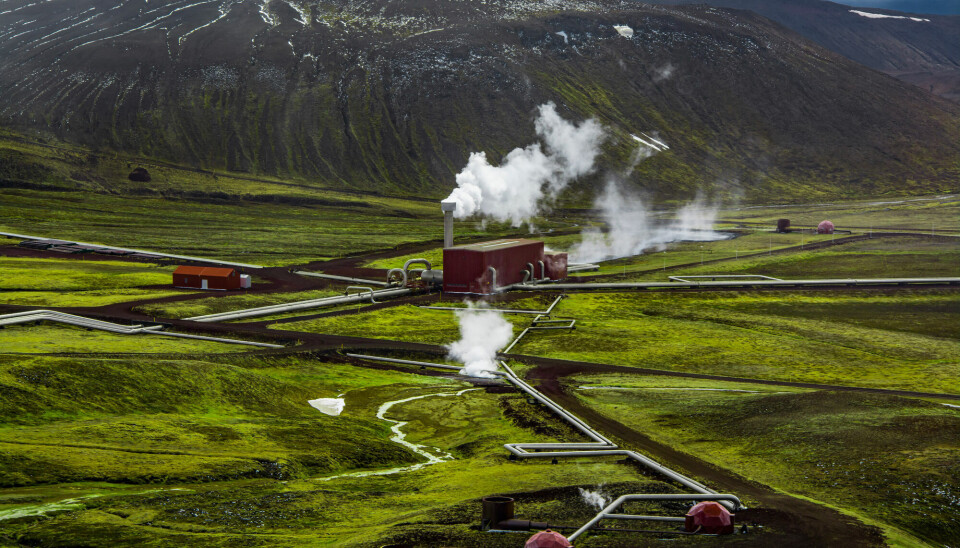
Geothermal heat can give the world energy, but it’s expensive
A Norwegian entrepreneur collaborates with researchers to find better ways to extract geothermal energy.
Per Arne Kjellgren is trying to do something to make expensive geothermal heat more attractive. In the same vein, he and his colleagues can help Norwegian experts on drilling for oil and gas to make a shift to drilling for heat.
Around the clock
“In terms of renewable energy we have the wind and the sun, but they’re inconsistent. The only renewable energy source that can be used around the clock all year round and anywhere on the planet, is geothermal energy,” says Kjellgren.
He is the founder and technical manager of the scientific software company FlowPhys. The small Østfold company collaborates with researchers and businesses from Romania, Great Britain and the volcanic country of Iceland. They are trying to find better ways to bring the geothermal heat to the surface.
Expensive and deep
The problem is that getting the heat – the geothermal energy – all the way up to the earth’s surface is too expensive. That’s not the case in Iceland and in other areas with active volcanoes and heat close to the surface, even dangerously close at times. But in most of the world the drilling has to be so deep that it’s not worth the cost.
At least not with today's methods. “But we’re working on a simulation tool that combines all the key findings that we’re receiving from the projects we participate in. That will allow us to significantly lower the cost of geothermal energy and make it more competitive commercially,” says Kjellgren.
Numerous projects
FlowPhys has become a regular participant in EU-funded research projects – so much so that the Research Council of Norway cites Kjellgren and his colleagues as models to follow. FlowPhys has received funding for eight different EU projects.
“In one project, we have a completely revolutionary technique for drilling,” Kjellgren says, “especially through hard bedrock such as granite. It’s much faster than traditional drilling technologies, and that alone can reduce costs drastically.”
Cheaper pipes
Researchers are also studying how they can replace expensive materials with much cheaper solutions. When you drill several kilometres straight down, you encounter a liquid that wears down the metal in the pipes.
“Avoiding that problem requires expensive materials like stainless steel or maybe even titanium, which costs a lot of money,” says Kjellgren.
But if you instead use cheap steel and cover it with an advanced surface layer that protects the metal, then it would be possible to have much lower costs. That’s where the simulation tool he’s mentioned becomes important: it can calculate exactly where the wear and tear is greatest.
Combining research findings
When the temperature in the pipes drops, there’s the risk that substances get released that block the pipes.
“How can we manage to extract more heat energy without plugging the pipes? If we can reach a temperature of maybe 40 degrees instead of 100, we might be able to more than double how much energy we can extract,” Kjellgren says.
“In principle, we can say that every project we’re working on looks at one or two key technologies. Then we try to combine these technologies in new software. We develop the tools, but then we collaborate in the EU projects to use the test data from various research institutes and universities,” he says.
130 to 200 degrees
Here we’re not talking about the heat that many homes and commercial buildings use for heat pumps. The researchers are working to enter a market that requires a much higher temperature – preferably 130 to 200 degrees – which is hot enough for the heat to be used to generate electricity.
Norway is not the ideal country for geothermal energy use. Drilling depths vary, but Kjellgren estimates six to seven kilometres would be needed in the Oslo area, for example. On the other hand, he believes that geothermal energy could be highly interesting for Norway because both the drilling and the equipment have so many similarities with the oil and gas industry. Norway can supply the world with its expertise in these fields.
District heating
Kirsti Midttømme says that Norwegian research contributes to geothermal energy in several countries.
“For example, we’re looking at how district heating plants that run on coal in Poland, Hungary and Slovakia could be converted to geothermal energy. The potential is huge,” she says.
Midttømme is a chief scientist at the research institute Norce.
“In Norway, we extract three to four terawatt hours from the ground with a heat pump. But people understand the concept a little differently. Most people think of geothermal energy as something that exists in countries like Iceland and Turkey,” she says.
“We’ve experimented with geothermal energy for electricity production in the Nordic countries outside of Iceland, but the temperature gets too low. Sweden has a plant where they’ve drilled down five or six kilometers, and it’s connected to the district heating. It isn’t profitable, but it was done to show that geothermal heating can work,” says Midttømme.
Translated by Ingrid Nuse
Read the Norwegian version of this article on forskning.no
Reference:
Andri Isak Thorhallsson, Francesco Fanicchia, Emily Davison, Shiladitya Paul, Svava Davidsdottir and Dagur Ingi Olafsson: Erosion and Corrosion Resistance Performance of Laser Metal Deposited High-Entropy Alloy Coatings at Hellisheidi Geothermal Site. Materials, May 2021, doi: 10.3390/ma14113071































